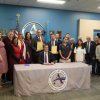World Honey Bee Day a reminder of extinction threat
World Honey Bee Day came and went Aug. 15, but it wasn’t a celebration: Over 40 percent of insect species are threatened with extinction.
Thanks to science, we know exactly why: habitat loss, invasive species, pollution from pesticides, and climate change all play a significant role. But because professional scientists only have so much time, they cannot collect all the data needed to understand where different species are or how populations are changing at the local or global scale. Without our help, professional researchers can’t speak strongly enough to advocate for the policies we need to reverse current trends.
One obvious solution to both challenges is citizen science, which brings the public into the research process. Through crowdsourcing, citizen science leads to more data, especially from places professional researchers cannot access. Citizen science also lets contributors to research advocate to drive direct change, letting their voices be heard through direct actions that can solve global problems.
Conservative estimates indicate that tens of millions of students and adults do some form of citizen science every year. Citizen science happens in schools, in informal education settings like museums, through corporate social responsibility expeditions, and in people’s backyards. The economic value of citizen science projects is uncertain, but some estimates calculate it in the billions of dollars for biodiversity monitoring alone.
Since 2010, there has been a significant rise in the number of peer-reviewed publications that mention citizen science, but its impact reaches far beyond data production. It is a powerful form of experiential learning for children and adults alike. It also supports enhanced scientific literacy among different public community members. Engaging people in citizen science and making research data open also democratizes science, which can increase belief and trust in science.
However, many citizen science projects are missing two key elements: first, providing access to comprehensive open source data, and second, providing pathways for participants to engage their governments through civic action. Without these two elements, citizen science misses an important opportunity to advance scientific research, and limits the potential to deepen the public’s engagement at the intersection of science and public policy.
A new citizen science project, Earth Challenge 2020 – led by Earth Day Network, the Wilson Center, and the U.S. Department of State – takes steps to address both issues. First, while some citizen science data is open source, it is not easily accessible to everyone in one place. One solution is creating the Citizen Science Cloud, a one-stop shop for citizen science data collected from a wide range of projects. Professional researchers can take advantage of open APIs (publicly available application programming interfaces), while everyday people can use data visualization and mapping tools to see what’s happening in their own communities.
Second, the Earth Challenge mobile app directly links science to action, an opportunity to use technology and data to drive change that is unique in the citizen science world. Once a user contributes data, whether taking a photo of a bee or classifying photos of plastic in the environment, they can take country-specific civic engagement actions, such as signing petitions, that are focused on impacting current policy decision-making processed at their national level. To address bee declines, for example, participants can petition their governments to ban certain pesticides, address agricultural practices that are decimating bee populations, or create habitats for bees and other pollinators. Guiding citizen scientists down the pathway of civic action builds a deeper relationship between critically important data and strong science-based policy.
Citizen science projects, if created with solid hypotheses and engaging technologies, can aid professional scientists who are interested in acquiring more data and support global monitoring against targets like the U.N. Sustainable Development Goals. Adding a civic action component to citizen science initiatives will build a broader, more diverse and more active global community of ordinary people who will take action to save their communities and the planet. Well-constructed citizen science, supported by open data and civic action, is a powerful force for the change our planet needs.





















































